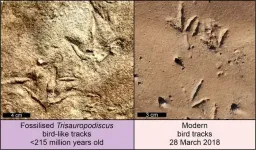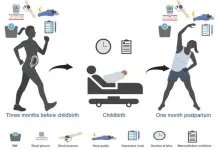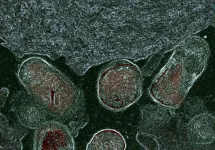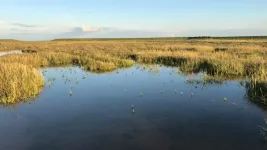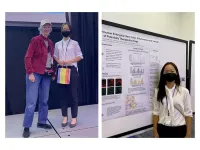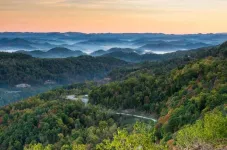(Press-News.org) Ancient animals were walking around on bird-like feet over 210 million years ago, according to a study published November 29, 2023 in the open-access journal PLOS ONE by Miengah Abrahams and Emese M. Bordy of the University of Cape Town, South Africa.
Numerous fossil sites in southern Africa preserve distinctive three-toed footprints that have been named Trisauropodiscus. For many years, researchers have debated what animals might have left these tracks, as well as precisely how many different species (technically called ichnospecies) of Trisauropodiscus there are.
In this study, the researchers reassessed the fossil record of these footprints, examining physical fossil traces alongside published materials documenting Trisauropodiscus at four sites in Lesotho dating to the Late Triassic and Early Jurassic Periods. The authors also provided a detailed field-based description of footprints from an 80-meter-long tracksite in Maphutseng. They identified two distinct morphologies among Trisauropodiscus footprints, the first of which is similar to certain non-bird dinosaur tracks, and the second of which is very similar in size and proportions to the footprints of birds.
These tracks aren’t a direct match for any fossil animals known from this region and time period. The most ancient of these footprints, at over 210 million years old, are 60 million years older than the earliest known body fossils of true birds. It’s possible that these tracks were produced by early dinosaurs, and potentially even early members of a near-bird lineage, but the authors note that there could also have been other reptiles, cousins of dinosaurs, that convergently evolved bird-like feet. Whoever the trackmakers are, these footprints establish the origin of bird-like feet at least as early as the Late Triassic Period.
The authors add: “Trisauropodiscus tracks are known from numerous southern African sites dating back to approximately 215 million years ago. The shape of the tracks is consistent with modern and more recent fossil bird tracks, but it is likely a dinosaur with a bird-like foot produced Trisauropodiscus.”
#####
In your coverage please use this URL to provide access to the freely available article in PLOS ONE: https://journals.plos.org/plosone/article?id=10.1371/journal.pone.0293021
Citation: Abrahams M, Bordy EM (2023) The oldest fossil bird-like footprints from the upper Triassic of southern Africa. PLoS ONE 18(11): e0293021. https://doi.org/10.1371/journal.pone.0293021
Author Countries: South Africa
Funding: This work was supported by the following grants: EMB (as PI) – National Research Foundation of South Africa Competitive Programme for Rated Researchers [93544, 113394], African Origins Platform [98825]; MA (as PI) – UCT Research Development Grant [2021, 2022], DSI – NRF Centre of Excellence in Palaeosciences (Genus) We Dig Fossils [86073]. MA also acknowledges DSI – NRF Centre of Excellence in Palaeosciences (Genus) postgraduate funding [2016 – 2018]. The funders had no role in the study design, data collection, analysis, decision to publish, or preparation of the manuscript. https://www.nrf.ac.za ; https://www.genus.africa.
END
Unknown animals were leaving bird-like footprints in Late Triassic Southern Africa
These tracks pre-date the oldest bird bone by around 60 million years
2023-11-29
ELSE PRESS RELEASES FROM THIS DATE:
Exercise may reduce postpartum depression, with moderate intensity exercises three to four times a week being especially effective, per meta-analysis
2023-11-29
Exercise may reduce postpartum depression, with moderate intensity exercises three to four times a week being especially effective, per meta-analysis
###
Article URL: https://journals.plos.org/plosone/article?id=10.1371/journal.pone.0287650
Article Title: Effectiveness of aerobic exercise in the prevention and treatment of postpartum depression: Meta-analysis and network meta-analysis
Author Countries: China
Funding: This work was financially supported by the Fundamental Research Funds for the Central Universities in China (Grant no. CUG150607). The funders did not play a role ...
Breaking down barriers: What happens when the vaginal microbiome attacks
2023-11-29
Bacterial vaginosis is a common condition in which the natural microbiome of the vagina falls out of balance, sometimes leading to complications in sexual and reproductive health. But exactly how these bacterial populations disrupt vaginal health has remained unclear.
Researchers at University of California San Diego School of Medicine have now found that in bacterial vaginosis, certain bacterial species dismantle protective molecules on the surface of the cells lining the vagina, dysregulating key processes that mediate cell turnover, death and response to surrounding bacteria.
The findings, published November 29, 2023 in Science Translational Medicine, may help explain why bacterial ...
Being prepared for storm surges on the Baltic Sea coast
2023-11-29
The record storm surge in October 2023 caused severe damage to the German Baltic coast. Effective adaptation scenarios to rising sea levels are therefore becoming increasingly urgent. In two recent studies, researchers at Kiel University have modelled both the flooding extent along the Baltic Sea coastal areas and, for the first time, two possible upgrades for current dike lines in high resolution. They modelled various storm surge and sea level rise scenarios. Their results show that, based on the current dike line, neither an increase ...
Findings challenge standard understanding of COVID-19 infection
2023-11-29
RIVERSIDE, Calif. -- Some viruses move between species. For example, SARS-CoV-2, the virus that causes COVID-19, can spill over from humans to mink, an agricultural species, and then spill back from mink to humans. Spill back is a concern because SARS-CoV-2 can mutate in the mink and come back to humans in a more virulent form. Both spill over and spill back of SARS-CoV-2 have been reported on mink farms in the United States and Europe.
To address these issues, a research team at the University of California, Riverside, has ...
Building the digital replica of our seas: an open call for crucial biodiversity data to restore ocean ecosystems
2023-11-29
The Horizon Europe DTO-BioFlow project (https://dto-bioflow.eu) has launched an Open Call offering up to 60,000€ for institutions that manage marine biodiversity data, to invite them to contribute to the European Digital Twin of the Ocean (EU DTO) by making these data available to the public domain through EMODnet Biology, the portal that provides open and free access to interoperable data and data products on temporal and spatial distribution of marine species (angiosperms, benthos, birds, fish, macroalgae, mammals, reptiles, phyto- and zooplankton) from European regional seas. Published officially on Tuesday, October 31st, this single-stage call is open to a wide ...
New research sheds light on Bantu-speaking populations' expansion in Africa
2023-11-29
About 350 million people across Africa speak one or more of the 500 Bantu languages. New genetic analysis of modern and ancient individuals suggests that these populations probably originated in western Africa and then moved south and east in several waves. The study has been published in the scientific journal Nature.
The expansion of people speaking Bantu languages is considered one of the most dramatic demographic events in Late Holocene Africa, which began 6,000 to 4,000 years ago in western Africa. This new study generated and analysed a comprehensive dataset, including genomic data of modern-day populations from 1,763 participants ...
Popularity matters more than compatibility on dating apps
2023-11-29
A new study has found that algorithms used by online dating platforms have popularity bias - meaning that they recommend more popular, attractive users over less popular, less attractive users. Researchers at Carnegie Mellon University and the University of Washington published their findings in Manufacturing & Service Operations Management.
They evaluated data from over 240,000 users of a major online dating platform in Asia over three months. They found that a user's chance of being recommended by the platform's algorithm ...
Markey Cancer Center research highlights need for education to combat cancer in Appalachia
2023-11-29
LEXINGTON, Ky. (Nov. 29, 2023) — University of Kentucky Markey Cancer Center research underscores the need for interventions to increase educational attainment and knowledge of cancer in Appalachian Kentucky.
Kentucky has the highest rate of cancer incidence and mortality in the country, with the Eastern Appalachian region bearing the highest burden due to health, socioeconomic and education disparities including decreased education attainment levels that cause lower health ...
Contraception: hormonal and copper coil only show minor differences
2023-11-29
In the “ThemenCheck Medizin” procedure offered by the German Institute for Quality and Efficiency in Health Care (IQWiG), interested members of the public can submit proposals for the assessment of medical procedures and technologies. On behalf of IQWiG, an interdisciplinary team of researchers led by Share to Care GmbH in Cologne investigated the advantages and disadvantages of two types of contraceptive coils (also known as intrauterine devices, IUDs) for preventing unwanted pregnancies, the copper IUD and the hormonal IUD.
Their conclusion: both types of IUDs are very safe and, compared to condoms or the pill, cost-effective contraceptive ...
The chip that makes calculations with light
2023-11-29
Optical wireless may no longer have any obstacles. A study by Politecnico di Milano, conducted together with Scuola Superiore Sant'Anna in Pisa, the University of Glasgow and Stanford University, and published in the prestigious journal Nature Photonics, has made it possible to create photonic chips that mathematically calculate the optimal shape of light to best pass through any environment, even one that is unknown or changing over time.
The problem is well known: light is sensitive to any form of obstacle, even very small ones. Think, for example, of how we see objects when looking through a frosted window ...
LAST 30 PRESS RELEASES:
Electrodes created using light
Second-hand gift-giving is a well-deliberated decision
How human interaction drove evolution to make bears less aggressive
National Poll: Few parents offer teens guidance on healthy eating during holiday season
Cannabis derivatives could provide new ovarian cancer treatments
Raising strong yeast as a petroleum substitute
Clues to the origin of hot Jupiters hidden in their orbits
Canada’s reduced pledge to Global Fund will impact domestic health
1 in 4 children with major traumatic injuries not cared for in pediatric trauma centres
Duke and Duke-NUS’ joint cross-population research to uncover "East-West" differences in disease and care
Scientists to ‘spy’ on cancer- immune cell interactions using quantum technology breakthrough
Tech savvy users have most digital concerns
Making lighter work of calculating fluid and heat flow
Normalizing blood sugar can halve heart attack risk
Lowering blood sugar cuts heart attack risk in people with prediabetes
Study links genetic variants to risk of blinding eye disease in premature infants
Non-opioid ‘pain sponge’ therapy halts cartilage degeneration and relieves chronic pain
AI can pick up cultural values by mimicking how kids learn
China’s ecological redlines offer fast track to 30 x 30 global conservation goal
Invisible indoor threats: emerging household contaminants and their growing risks to human health
Adding antibody treatment to chemo boosts outcomes for children with rare cancer
Germline pathogenic variants among women without a history of breast cancer
Tanning beds triple melanoma risk, potentially causing broad DNA damage
Unique bond identified as key to viral infection speed
Indoor tanning makes youthful skin much older on a genetic level
Mouse model sheds new light on the causes and potential solutions to human GI problems linked to muscular dystrophy
The Journal of Nuclear Medicine ahead-of-print tip sheet: December 12, 2025
Smarter tools for peering into the microscopic world
Applications open for funding to conduct research in the Kinsey Institute archives
Global measure underestimates the severity of food insecurity
[Press-News.org] Unknown animals were leaving bird-like footprints in Late Triassic Southern AfricaThese tracks pre-date the oldest bird bone by around 60 million years
